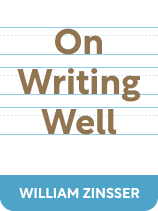

This article is an excerpt from the Shortform book guide to "On Writing Well" by William Zinsser. Shortform has the world's best summaries and analyses of books you should be reading.
Like this article? Sign up for a free trial here .
Do you struggle to get your point across in your writing? Do you want to learn to write clearly and concisely?
The two most important rules for clear writing are to follow a logical sequence and to be consistent. And, of course, you need to thoroughly understand the material you are writing about.
Here’s how to write clearly, according to journalist William Zinsser.
What Is Clarity?
In the book On Writing Well, William Zinsser believes that it’s your job as a writer to guide the reader through your thought process rather than forcing them to dissect disorganized or underdeveloped writing.
Zinsser believes that to write clearly, you must clearly understand the topic you’re writing about. If you don’t understand the topic, you’ll never be able to explain it well to your reader.
| Occam’s Razor and Clear Writing Another way to think of Zinsser’s idea of clarity is through the principle of Occam’s razor. This is the idea that the simplest solution is often the best one. In writing, this means you should discard as much unnecessary information as possible and just stick to the essential facts. To apply this principle, keep these four questions in mind: What’s your central message? What’s the best structure to communicate this message? What background does the audience need to know? How long should each point or topic be? To answer these questions in a useful way, you need to fully understand the material you’re writing about. |
1. Follow a Logical Sequence
To write with clarity, follow a logical sequence of ideas. Each sentence should build off of the idea in the previous sentence. To lead your reader to your next thought, Zinsser recommends anticipating what the reader will ask and answering their question in the next sentence. Constantly ask yourself, “What is the next thing the reader needs to know?” Then answer that question in the next sentence rather than repeating the previous sentence in a different way.
(Shortform note: Truly logical writing answers a reader’s questions before they have a chance to ask them. To make your writing more logical, experts recommend this general formula: state each idea, provide evidence for that idea, and draw a clear connection to the conclusion. This formula works for any kind of argument or proposal. But the formula can also be applied to creative nonfiction like memoirs or travel writing. Your evidence will probably come in the form of the detail you give the reader to back up your claims. For example, instead of just stating someone’s name and occupation, you could describe their uniform. This description would provide evidence to support the idea of their occupation.)
2. Be Consistent
Consistency, or what Zinsser calls unity, is when certain key elements of your writing stay the same throughout your writing, even as your idea develops. Zinsser believes consistency eliminates unwanted confusion because your reader won’t have to keep up with unnecessary changes in your writing. Keep these three elements consistent throughout your writing:
- Main idea: Your main idea is the most important takeaway from a piece—it’s your whole reason for writing that specific story. Zinsser explains that your main idea will guide your writing and prevent unrelated tangents.
- Point of view: Your point of view is how you narrate your piece. Your point of view establishes a relationship with the reader since it’s how you’ll refer to yourself throughout the story.
- Tense: Tense refers to whether you’re telling your story from the past, present, or future. Zinsser notes that tenses help your reader situate themselves in the timeline of events.
- Tone: Zinsser explains that tone signals what you think or how you feel about your topic. For example, you could take a lighthearted, nostalgic, or formal tone toward your writing.
Zinsser explains that while you can take some artistic liberty with your writing, you have to stick with whatever decisions you make. As you write, you can change your mind, but make sure that change is reflected throughout the rest of your writing. For example, you may start writing a piece in third person, only to decide midway through that you think first person would work better. It’s okay to change your mind, but be sure to go back and change the parts you’ve already written in third person to first person.
(Shortform note: Zinsser points out the importance of consistency with big decisions like tone, main idea, tense, and point of view. But it’s also important to be consistent for small decisions like punctuation and spelling. To ensure consistency in writing, some publications and businesses adhere to a style guide. Some of the more common style guides are AP style, Chicago style, APA style, and MLA style. You can use these guides as a reference to answer certain consistency questions about spelling, word hyphenation, punctuation, and more.)

———End of Preview———
Like what you just read? Read the rest of the world's best book summary and analysis of William Zinsser's "On Writing Well" at Shortform .
Here's what you'll find in our full On Writing Well summary :
- A back-to-basics approach to the craft of writing
- How to practice simple, clear, and engaging writing—even if you're not a writer
- How to effectively put your ideas into words






